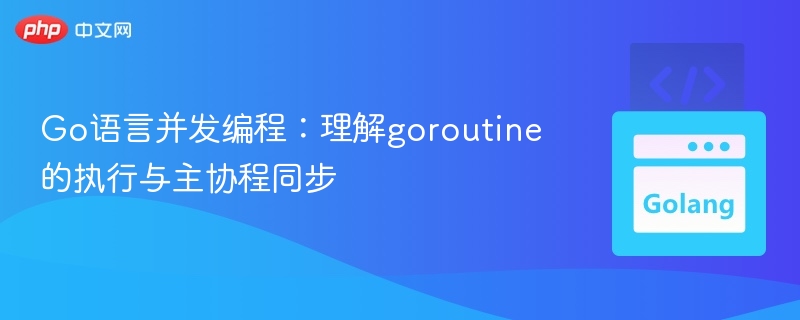Go如何实现HTTP请求限流示例
IT行业相对于一般传统行业,发展更新速度更快,一旦停止了学习,很快就会被行业所淘汰。所以我们需要踏踏实实的不断学习,精进自己的技术,尤其是初学者。今天golang学习网给大家整理了《Go如何实现HTTP请求限流示例》,聊聊限流、HTTP,我们一起来看看吧!
在开发高并发系统时有三把利器用来保护系统:缓存、降级和限流!为了保证在业务高峰期,线上系统也能保证一定的弹性和稳定性,最有效的方案就是进行服务降级了,而限流就是降级系统最常采用的方案之一。
这里为大家推荐一个开源库 https://github.com/didip/tollbooth 但是,如果您想要一些简单的、轻量级的或者只是想要学习的东西,实现自己的中间件来处理速率限制并不困难。今天我们就来聊聊如何实现自己的一个限流中间件
首先我们需要安装一个提供了 Token bucket (令牌桶算法)的依赖包,上面提到的toolbooth 的实现也是基于它实现的
$ go get golang.org/x/time/rate
好了我们先看Demo代码的实现:
limit.go
package main
import (
"net/http"
"golang.org/x/time/rate"
)
var limiter = rate.NewLimiter(2, 5)
func limit(next http.Handler) http.Handler {
return http.HandlerFunc(func(w http.ResponseWriter, r *http.Request) {
if limiter.Allow() == false {
http.Error(w, http.StatusText(429), http.StatusTooManyRequests)
return
}
next.ServeHTTP(w, r)
})
}
main.go
package main
import (
"net/http"
)
func main() {
mux := http.NewServeMux()
mux.HandleFunc("/", okHandler)
// Wrap the servemux with the limit middleware.
http.ListenAndServe(":4000", limit(mux))
}
func okHandler(w http.ResponseWriter, r *http.Request) {
w.Write([]byte("OK"))
}
我们看看 rate.NewLimiter的源码:
// Copyright 2015 The Go Authors. All rights reserved.
// Use of this source code is governed by a BSD-style
// license that can be found in the LICENSE file.
// Package rate provides a rate limiter.
package rate
import (
"fmt"
"math"
"sync"
"time"
"golang.org/x/net/context"
)
// Limit defines the maximum frequency of some events.
// Limit is represented as number of events per second.
// A zero Limit allows no events.
type Limit float64
// Inf is the infinite rate limit; it allows all events (even if burst is zero).
const Inf = Limit(math.MaxFloat64)
// Every converts a minimum time interval between events to a Limit.
func Every(interval time.Duration) Limit {
if interval burst {
tokens = burst
}
// update state
r.lim.last = now
r.lim.tokens = tokens
if r.timeToAct == r.lim.lastEvent {
prevEvent := r.timeToAct.Add(r.limit.durationFromTokens(float64(-r.tokens)))
if !prevEvent.Before(now) {
r.lim.lastEvent = prevEvent
}
}
return
}
// Reserve is shorthand for ReserveN(time.Now(), 1).
func (lim *Limiter) Reserve() *Reservation {
return lim.ReserveN(time.Now(), 1)
}
// ReserveN returns a Reservation that indicates how long the caller must wait before n events happen.
// The Limiter takes this Reservation into account when allowing future events.
// ReserveN returns false if n exceeds the Limiter's burst size.
// Usage example:
// r, ok := lim.ReserveN(time.Now(), 1)
// if !ok {
// // Not allowed to act! Did you remember to set lim.burst to be > 0 ?
// }
// time.Sleep(r.Delay())
// Act()
// Use this method if you wish to wait and slow down in accordance with the rate limit without dropping events.
// If you need to respect a deadline or cancel the delay, use Wait instead.
// To drop or skip events exceeding rate limit, use Allow instead.
func (lim *Limiter) ReserveN(now time.Time, n int) *Reservation {
r := lim.reserveN(now, n, InfDuration)
return &r
}
// Wait is shorthand for WaitN(ctx, 1).
func (lim *Limiter) Wait(ctx context.Context) (err error) {
return lim.WaitN(ctx, 1)
}
// WaitN blocks until lim permits n events to happen.
// It returns an error if n exceeds the Limiter's burst size, the Context is
// canceled, or the expected wait time exceeds the Context's Deadline.
func (lim *Limiter) WaitN(ctx context.Context, n int) (err error) {
if n > lim.burst {
return fmt.Errorf("rate: Wait(n=%d) exceeds limiter's burst %d", n, lim.burst)
}
// Check if ctx is already cancelled
select {
case maxElapsed {
elapsed = maxElapsed
}
// Calculate the new number of tokens, due to time that passed.
delta := lim.limit.tokensFromDuration(elapsed)
tokens := lim.tokens + delta
if burst := float64(lim.burst); tokens > burst {
tokens = burst
}
return now, last, tokens
}
// durationFromTokens is a unit conversion function from the number of tokens to the duration
// of time it takes to accumulate them at a rate of limit tokens per second.
func (limit Limit) durationFromTokens(tokens float64) time.Duration {
seconds := tokens / float64(limit)
return time.Nanosecond * time.Duration(1e9*seconds)
}
// tokensFromDuration is a unit conversion function from a time duration to the number of tokens
// which could be accumulated during that duration at a rate of limit tokens per second.
func (limit Limit) tokensFromDuration(d time.Duration) float64 {
return d.Seconds() * float64(limit)
}
算法描述:
用户配置的平均发送速率为r,则每隔1/r秒一个令牌被加入到桶中(每秒会有r个令牌放入桶中),桶中最多可以存放b个令牌。如果令牌到达时令牌桶已经满了,那么这个令牌会被丢弃;
实现用户粒度的限流
虽然在某些情况下使用单个全局速率限制器非常有用,但另一种常见情况是基于IP地址或API密钥等标识符为每个用户实施速率限制器。我们将使用IP地址作为标识符。简单实现代码如下:
package main
import (
"net/http"
"sync"
"time"
"golang.org/x/time/rate"
)
// Create a custom visitor struct which holds the rate limiter for each
// visitor and the last time that the visitor was seen.
type visitor struct {
limiter *rate.Limiter
lastSeen time.Time
}
// Change the the map to hold values of the type visitor.
var visitors = make(map[string]*visitor)
var mtx sync.Mutex
// Run a background goroutine to remove old entries from the visitors map.
func init() {
go cleanupVisitors()
}
func addVisitor(ip string) *rate.Limiter {
limiter := rate.NewLimiter(2, 5)
mtx.Lock()
// Include the current time when creating a new visitor.
visitors[ip] = &visitor{limiter, time.Now()}
mtx.Unlock()
return limiter
}
func getVisitor(ip string) *rate.Limiter {
mtx.Lock()
v, exists := visitors[ip]
if !exists {
mtx.Unlock()
return addVisitor(ip)
}
// Update the last seen time for the visitor.
v.lastSeen = time.Now()
mtx.Unlock()
return v.limiter
}
// Every minute check the map for visitors that haven't been seen for
// more than 3 minutes and delete the entries.
func cleanupVisitors() {
for {
time.Sleep(time.Minute)
mtx.Lock()
for ip, v := range visitors {
if time.Now().Sub(v.lastSeen) > 3*time.Minute {
delete(visitors, ip)
}
}
mtx.Unlock()
}
}
func limit(next http.Handler) http.Handler {
return http.HandlerFunc(func(w http.ResponseWriter, r *http.Request) {
limiter := getVisitor(r.RemoteAddr)
if limiter.Allow() == false {
http.Error(w, http.StatusText(429), http.StatusTooManyRequests)
return
}
next.ServeHTTP(w, r)
})
}
当然这只是一个简单的实现方案,如果我们要在微服务的API-GateWay中去实现限流还是要考虑很多东西的。建议大家可以看看 https://github.com/didip/tollbooth 的源码。
今天关于《Go如何实现HTTP请求限流示例》的内容就介绍到这里了,是不是学起来一目了然!想要了解更多关于golang的内容请关注golang学习网公众号!
 解读golang plugin热更新尝试
解读golang plugin热更新尝试
- 上一篇
- 解读golang plugin热更新尝试

- 下一篇
- golang中for循环遍历channel时需要注意的问题详解
-

- Golang · Go教程 | 1小时前 |
- Golang云原生应用部署回滚与版本控制
- 136浏览 收藏
-

- Golang · Go教程 | 1小时前 |
- Golang中go.sum文件的作用 分析模块校验与安全机制
- 359浏览 收藏
-

- Golang · Go教程 | 1小时前 |
- 如何在Golang中实现服务限流_Golang 微服务限流控制实践
- 130浏览 收藏
-

- Golang · Go教程 | 2小时前 |
- 如何配置Golang单元测试环境_Golang单元测试环境准备
- 241浏览 收藏
-

- Golang · Go教程 | 2小时前 |
- 如何在Golang中实现策略模式
- 101浏览 收藏
-

- Golang · Go教程 | 2小时前 | golang rpc
- Golang RPC客户端连接池优化与性能提升示例
- 292浏览 收藏
-

- Golang · Go教程 | 2小时前 |
- 如何为Golang项目选择合适的IDE_Golang IDE选择与优化建议
- 443浏览 收藏
-

- Golang · Go教程 | 2小时前 |
- Go语言并发编程:理解goroutine的执行与主协程同步
- 350浏览 收藏
-

- Golang · Go教程 | 2小时前 |
- 如何使用Golang实现微服务版本控制_使用路由和Header区分服务版本
- 177浏览 收藏
-

- Golang · Go教程 | 2小时前 |
- Golang WaitGroup中怎么返回错误_Golang并发错误汇总模板
- 112浏览 收藏
-

- Golang · Go教程 | 3小时前 |
- Golang如何为项目创建Env配置文件_GoEnv文件结构说明
- 327浏览 收藏
-

- Golang · Go教程 | 3小时前 |
- 如何用Golang实现指针切片操作_Golang 切片指针使用实践
- 252浏览 收藏
-

- 前端进阶之JavaScript设计模式
- 设计模式是开发人员在软件开发过程中面临一般问题时的解决方案,代表了最佳的实践。本课程的主打内容包括JS常见设计模式以及具体应用场景,打造一站式知识长龙服务,适合有JS基础的同学学习。
- 543次学习
-

- GO语言核心编程课程
- 本课程采用真实案例,全面具体可落地,从理论到实践,一步一步将GO核心编程技术、编程思想、底层实现融会贯通,使学习者贴近时代脉搏,做IT互联网时代的弄潮儿。
- 516次学习
-

- 简单聊聊mysql8与网络通信
- 如有问题加微信:Le-studyg;在课程中,我们将首先介绍MySQL8的新特性,包括性能优化、安全增强、新数据类型等,帮助学生快速熟悉MySQL8的最新功能。接着,我们将深入解析MySQL的网络通信机制,包括协议、连接管理、数据传输等,让
- 500次学习
-

- JavaScript正则表达式基础与实战
- 在任何一门编程语言中,正则表达式,都是一项重要的知识,它提供了高效的字符串匹配与捕获机制,可以极大的简化程序设计。
- 487次学习
-

- 从零制作响应式网站—Grid布局
- 本系列教程将展示从零制作一个假想的网络科技公司官网,分为导航,轮播,关于我们,成功案例,服务流程,团队介绍,数据部分,公司动态,底部信息等内容区块。网站整体采用CSSGrid布局,支持响应式,有流畅过渡和展现动画。
- 485次学习
-

- ChatExcel酷表
- ChatExcel酷表是由北京大学团队打造的Excel聊天机器人,用自然语言操控表格,简化数据处理,告别繁琐操作,提升工作效率!适用于学生、上班族及政府人员。
- 3374次使用
-

- Any绘本
- 探索Any绘本(anypicturebook.com/zh),一款开源免费的AI绘本创作工具,基于Google Gemini与Flux AI模型,让您轻松创作个性化绘本。适用于家庭、教育、创作等多种场景,零门槛,高自由度,技术透明,本地可控。
- 3583次使用
-

- 可赞AI
- 可赞AI,AI驱动的办公可视化智能工具,助您轻松实现文本与可视化元素高效转化。无论是智能文档生成、多格式文本解析,还是一键生成专业图表、脑图、知识卡片,可赞AI都能让信息处理更清晰高效。覆盖数据汇报、会议纪要、内容营销等全场景,大幅提升办公效率,降低专业门槛,是您提升工作效率的得力助手。
- 3615次使用
-

- 星月写作
- 星月写作是国内首款聚焦中文网络小说创作的AI辅助工具,解决网文作者从构思到变现的全流程痛点。AI扫榜、专属模板、全链路适配,助力新人快速上手,资深作者效率倍增。
- 4746次使用
-

- MagicLight
- MagicLight.ai是全球首款叙事驱动型AI动画视频创作平台,专注于解决从故事想法到完整动画的全流程痛点。它通过自研AI模型,保障角色、风格、场景高度一致性,让零动画经验者也能高效产出专业级叙事内容。广泛适用于独立创作者、动画工作室、教育机构及企业营销,助您轻松实现创意落地与商业化。
- 3989次使用
-
- HTTP 的 response 中的响应体和头部是分开发送的吗?
- 2023-01-28 387浏览
-
- Go语言框架快速集成限流中间件详解
- 2022-12-23 290浏览
-
- B站等视频网站的弹幕用的是 websocket 还是轮询?
- 2023-02-16 447浏览
-
- Golang官方限流器库实现限流示例详解
- 2023-01-07 376浏览
-
- Golang实现HTTP编程请求和响应
- 2022-12-28 101浏览



